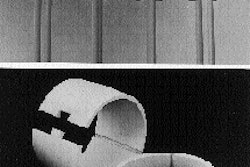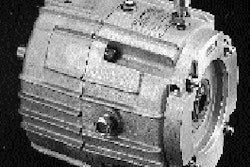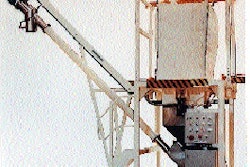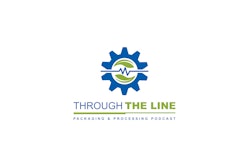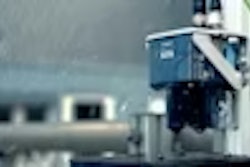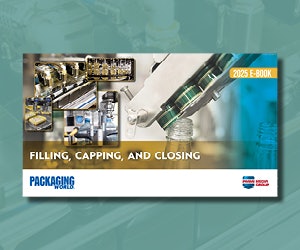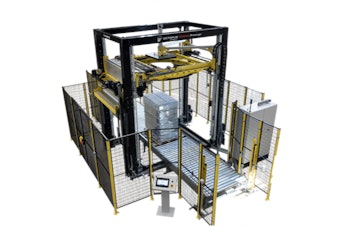Warehousing and shipping pallet loads of dry pet foods may not sound like high-tech packaging. However, a PLC-controlled print-and-apply pallet labeling system used by Heinz Pet Products at its Kankakee, IL, warehouse/distribution center is quite sophisticated. Installed last March, America's Leading Edge Systems' (Kalamazoo, MI) Model 6576 pallet load label printer/applicator replaced a prototype model from the same supplier that was installed in mid-'94. The primary advance for the 6576 version is an Allen-Bradley (Milwaukee, WI) programmable logic controller that links the labeler to other A-B-controlled computers used within the warehouse for a variety of functions. Before it tested the prototype, Heinz Pet Products labeled pallets manually. "We had a labeling person on each of our three daily shifts, five days a week," says Brian Piotrowski, dry conversion supervisor for HPP, a division of Heinz Co.'s Star-Kist Foods. "Automating the function saves us about $2ꯠ a week, and that's big money." Beyond economics, automated print-and-apply labeling all but eliminates prior difficulties such as labels printed with inaccurate information, missing labels, or inconsistently applied labels. Two-carriage wrapping At the Kankakee facility, dry pet food products (such as the bags of Gravy Train® shown in the accompanying photos) are filled into multiwall paper bags holding up to 50 lb each. Filled and sealed bags are automatically palletized before they index along a common conveyor for stretch wrapping. First, however, Heinz applies a 4-mil cover of plastic film to the top of the load. A custom-fabricated top sheet device from Lake Shore Plastics (Chicago, IL) feeds the film over the top of the load. The film clings to the load. It also provides additional strength that permits double-stacking of loads in Heinz's warehouse. LSP also distributes the film, though it won't reveal specifics. Top-capped loads are then ready for stretch wrapping on a Kaufman (Toledo, OH) EXPA-23 rotary machine. Interestingly, the wrapper uses two carriages to simultaneously apply two rolls of film to the load as the load rotates on a turntable. One carriage moves vertically along a pedestal to apply a 20"-wide web of 80-ga linear low-density polyethylene film from Presto Products (Appleton, WI). A second carriage positioned on the opposite side of the machine remains stationary. This carriage applies a 10"-wide web of film along the bottom of the load as it revolves. As a result, the bottom receives several layers of film. This added support is particularly helpful in dry pet food applications where the weight of the bagged product can sometimes cause bottom layers to bulge. The thicker film along the bottom of the load provides additional abrasion-resistance, though it's still no match against forklift tines. The two-carriage wrapping technique may be unusual but it's not new, according to Kaufman. The manufacturer has customized such wrappers for other pet food producers. Heinz's system was installed in '93. Easy media changeover Stretch-wrapped loads then head to the Model 6576 print-and-apply labeler. Labels are printed on demand, typically with manufacturing date, plant identifier, shift/hour code and time of day. The thermal-transfer print ribbon comes in 600-meter lengths, which is considerably longer than a standard ribbon, but matches the length of the label roll. This allows operators to change ribbon and pressure-sensitive label rolls at the same time, thereby reducing downtime. Control with a 'C' Within the warehouse, an Allen-Bradley PLC 5 system controls palletizer and conveyor functions. An Allen-Bradley SLC 5/03 controls the labeling head. This system is compatible with the PLC 5, enabling operators to easily control labeling and pallet movement. The SLC 5/03 permits easy labeling set-up, while also providing status indicators and self-diagnostic messages during operation. Heinz's system was customized by Doug MacLean, America's Leading Edge Systems' technical director. Besides designing, fabricating, assembling and installing the system, he also helped train Heinz operators on its use. The PLC 5 signals the labeler to print two labels with identical information, to be applied to the side and back of each pallet. Time and information are automatically formatted by the PLC 5, with that data sent to the printer. Printing functions are fully programmable with a keypad and display terminal. The pallet continues in front of the labeler, which dispenses the first label and holds it by vacuum. An articulating swing arm moves toward the side of the load. As an applicator head at the end of the arm senses contact with the load, the swing arm articulates so that the applicator head can align itself parallel with the side. As this happens, fingers extend and conform the label to the surface of the stretch-wrapped load. When the swing arm retracts, the load begins to move again. A second label is printed, dispensed and held in place by vacuum. As the load passes the labeler, the swing arm moves to apply the second label to the back side of the load. For this label, the arm makes a different movement. Again the swing arm retracts. The next stretch-wrapped pallet is then released to the labeler. A proximity sensor detects whether the arm has fully retracted. "This is an important protective measure that helps prevent another pallet load from accidentally breaking off the swing arm," notes Piotrowski. The labeled pallet is then released for storage in the Kankakee warehouse. "We specified the Allen-Bradley unit on the print-and-apply labeler because all the control systems we use in this area of the warehouse are from them," says Piotrowski. "We can relay messages back and forth between the labeler and our warehouse systems. That enables us to perform troubleshooting from our main system, so it all works together as an information highway. "The system has been running efficiently 24 hours a day, five days a week since its installation. We're extremely pleased with its performance," Piotrowski exclaims. "We run about a pallet a minute through the system and we supply the entire Midwest with product. This also gives us the capability to add bar coding, which will be a significant advance for us."




